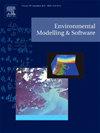使用可解释的机器学习方法进行冰堵塞洪水预测
IF 4.6
2区 环境科学与生态学
Q1 COMPUTER SCIENCE, INTERDISCIPLINARY APPLICATIONS
引用次数: 0
摘要
机器学习算法已被用于河流冰的洪水估计研究。本研究旨在引入一种基于机器学习的模型来预测冰塞洪水。使用随机建模方法创建了一个冰塞数据集,其中模拟了数千种可能的情况。这种方法将流体动力学模型RIVICE集成到蒙特卡罗分析(MOCA)框架中。然后将参数集、边界条件和相关的回水水位高度应用于机器学习算法,将决策树回归量(DTR)与自适应增强(AdaBoost)回归量相结合,实现初步的冰塞洪水预测模型。然后在初步模型中应用Shapley加性解释(SHAP)来确定影响冰塞洪水的最重要参数。然后利用从SHAP中识别出的变量,构建了一个变量较少的简单冰堵塞洪水灾害预测模型。加拿大麦克默里堡的阿萨巴斯卡河是这个模型框架的试验场。本文章由计算机程序翻译,如有差异,请以英文原文为准。
Ice-jam flood predictions using an interpretable machine learning approach
Machine-learning algorithms have been employed in river ice research for flood estimation. This study aimed to introduce a machine learning-based model for predicting ice jam floods. An ice-jam dataset was created using a stochastic modelling approach in which thousands of possible scenarios were simulated. This approach integrated a hydrodynamic model, RIVICE, into a Monte Carlo Analysis (MOCA) framework. The set of parameters, boundary conditions, and associated backwater level elevations was then applied to a machine-learning algorithm to implement a preliminary ice-jam flood prediction model, combining decision tree regressors (DTR) with an adaptive boosting (AdaBoost) regressor. Shapley Additive explanations (SHAP) were then applied in the preliminary model to identify the most influential parameters of ice-jam flooding. Identified variables from SHAP were then used to construct a simple ice-jam flood hazard prediction model with fewer variables. The Athabasca River in Fort McMurray, Canada, is a test site for this modelling framework.
求助全文
通过发布文献求助,成功后即可免费获取论文全文。
去求助
来源期刊

Environmental Modelling & Software
工程技术-工程:环境
CiteScore
9.30
自引率
8.20%
发文量
241
审稿时长
60 days
期刊介绍:
Environmental Modelling & Software publishes contributions, in the form of research articles, reviews and short communications, on recent advances in environmental modelling and/or software. The aim is to improve our capacity to represent, understand, predict or manage the behaviour of environmental systems at all practical scales, and to communicate those improvements to a wide scientific and professional audience.
 求助内容:
求助内容: 应助结果提醒方式:
应助结果提醒方式:


